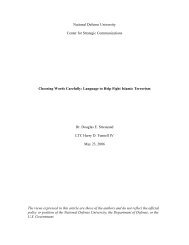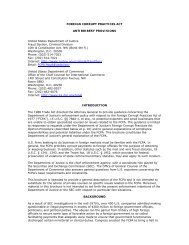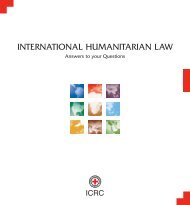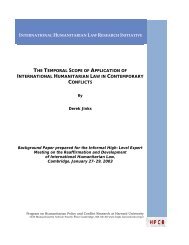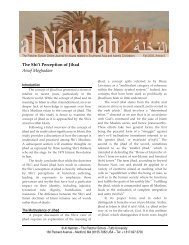some reflection on post-enlightenment qur'anic hermeneutics
some reflection on post-enlightenment qur'anic hermeneutics
some reflection on post-enlightenment qur'anic hermeneutics
Create successful ePaper yourself
Turn your PDF publications into a flip-book with our unique Google optimized e-Paper software.
1418 Michigan State Law Review [Vol. 2006:1403these hermeneutic traditi<strong>on</strong>s similarly emerged in the nineteenth and twentiethcenturies and sought to universalize the methodologies employed in theinterpretati<strong>on</strong> of important religious and classical texts, while drawing benefitsand insights from Enlightenment and Post-Enlightenment ideas and approachesto human understanding and the human sciences. 57The Post-Enlightenment Islamic tafsir can thus be situated in a largerhermeneutical history that transcends all of the Abrahamic religi<strong>on</strong>s andtakes within its sweep c<strong>on</strong>siderati<strong>on</strong> of Western literary, scientific, ethical,imply that the church ought to impose an external interpretati<strong>on</strong> to make them intelligible; itmerely reflected the insufficient knowledge and faulty preparati<strong>on</strong> of the interpreters.” Id.(quoting Kurt Mueller-Vollmer, Introducti<strong>on</strong> to THE HERMENEUTICS READER: TEXTS OF THEGERMAN TRADITION FROM THE ENLIGHTENMENT TO THE PRESENT 2 (Kurt Mueller-Vollmered., 1985) [hereinafter THE HERMENEUTICS READER].The Enlightenment led scholars and hermeneuts to view scriptural texts in thesame way that secular texts were viewed. “The process of the secularizati<strong>on</strong> of the Bible,begun by the Reformati<strong>on</strong> and c<strong>on</strong>tinued by eighteenth century rati<strong>on</strong>alism, becomes moreradical with the Enlightenment.” FERRARIS, supra note 8, at 52. “The rati<strong>on</strong>alist impulse,which fosters the secularizati<strong>on</strong> of the sacred text (the study, through the most advancedhistorical and philological tools, of the biblical traditi<strong>on</strong> as a literary <strong>on</strong>e), originates from theprejudice, influential in the Enlightenment, that the moderns are superior to the ancients andthat the more reas<strong>on</strong> is aut<strong>on</strong>omous, the more it is effective.” Id. “As far as the developmentof general <strong>hermeneutics</strong> is c<strong>on</strong>cerned, Chladenius (1710-1759) is the most important figuream<strong>on</strong>g the philosophers of Enlightenment.” Afaki, supra note 55. See also FERRARIS, supranote 8, at 64-65. In Chladenius’ view, <strong>hermeneutics</strong> is the art of attaining the perfect orcomplete understanding of utterances, whether they be speeches or writings. Id.56. Friedrich Ast is a pivotal figure in examining early modern Protestant <strong>hermeneutics</strong>,the precursor to the more general theory of <strong>hermeneutics</strong> that emerged from the Enlightenment.See Ramberg & Gjesdal, supra note 8. “Am<strong>on</strong>g the Romantic thinkers, FriedrichAst . . . was the most important <strong>on</strong>e who he had a deep impact <strong>on</strong> [the later] Schleiermacherianapproach toward general <strong>hermeneutics</strong>.” Afaki, supra note 55. According to Ast,“[i]ndividual utterances are neither to be understood with reference to their author, nor withreference to their place within the semiotic system, but according to their locati<strong>on</strong> withinworld-history.” Ramberg & Gjesdal, supra note 8. “Ast thereby extends the scope of thehermeneutic circle. Originally c<strong>on</strong>ceived in terms of the relati<strong>on</strong>ship between the parts andthe whole of the text, the hermeneutic circle now includes the text’s relati<strong>on</strong>ship to historicaltraditi<strong>on</strong> and culture at large.” Id. Afaki notes that:[H]ermeneutics for Ast . . . [becomes] a three-dimensi<strong>on</strong>al activity, that is, it maybe the historical, the grammatical or the spiritual (geistige). In the historical <strong>hermeneutics</strong>,a text is to be understood ‘in relati<strong>on</strong> to the c<strong>on</strong>tent of the work.’ In thegrammatical <strong>hermeneutics</strong> . . . a text is to be understood ‘in relati<strong>on</strong> to the language.’And in the geistige <strong>hermeneutics</strong>, a text is to be understood ‘in relati<strong>on</strong> tothe total view of the author and the total view of the age.[’]Afaki, supra note 55. “[T]he third <strong>on</strong>e was an original c<strong>on</strong>tributi<strong>on</strong> of Ast to the rise ofgeneral <strong>hermeneutics</strong> and it is the type . . . which was further developed by Schleiermacher.”Afaki, supra note 55.57. See Werner G. Jeanr<strong>on</strong>d, Hermeneutics, in A DICTIONARY OF BIBLICALINTERPRETATION 282-84 (R.J. Coggins & J.L. Houlden eds., 1990).



